|
|
Created/dedicated as per personal communication with Cristina J. Sheats, Cheyenne, Wyoming, August 27, 2010
Updated as per James P. Tuttle's The Hawk Moths of North America, August 27, 2010
Updated as per Butterflies and Moths of North America, formerly USGS, August 27, 2010
|
Laramie County, Wyoming
Sphingidae Larvae
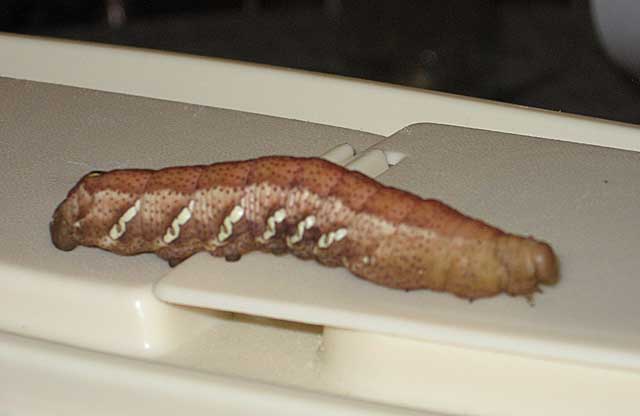
Eumorpha achemon fifth instar, Cheyenne, Laramie County, Wyoming,
August 27, 2010, courtesy of Cristina J. Sheats.
Please help me develop this list with improved, documented accuracy by
sending sightings (species, date, location), preferably with an
image, via email to
Bill Oehlke.
I do not have confirmed reports of all of these species in Laramie County, but I (WO) expect they are present.
For care of "found larvae/caterpillars" visit Manduca sexta larva, central Texas, August 21, 2008, Trina Woodall.
This page is inspired by and dedicated to Cristina J. Sheats of Cheyenne, Laramie County, Wyoming,
for her interest in lepidoptera.
Cristina also provides the images of a Eumorpha achemon larva at top and bottom of this page, and she has confirmed Hyles lineata
in Laramie County.
Cristina writes, "We live in Cheyenne, Wyoming, North America. We found this guy crawling across some broken bricks near the parking lot at my children's
school today.
There were Four-O-Clocks about 5-6 ft from his location (across dirt and gravel) and another kind of plant in the other direction (same inbetween terrain),
but he doesn't seem interested in eating either of them. The Four-O-Clocks are looking a bit stressed because of their dry, sunny location (they are not
in a garden, but just "weeds" growing along a wall) but I don't know how much caterpillars care about that sort of thing.
"As you can see in the pictures he's relatively big... nearly 3 inches. His most distinctive features are the white squiggly slashes on his sides and
the "cat's eye" mark on his tail. As you can see in the picture, the "cat's eye" marking is flush with his skin, but it is hard like a little button.
We have found White-lined Sphinx Moth larva in these Four-O-Clocks in the past, but they've always been of the green or green and black varity. I've
searched every caterpillar site I can find, but no one has one - brown, hairless, white slashes, no protrusions - like him that I can find. I wondered if
that button could be a broken horn, but I can't even find one with a tail horn that matches his description.
I'll be glad to answer any questions that I can. We were hoping to make a habitat and keep him til he turns, but if we can't figure out what he is or what
he eats, that won't be possible. We are hoping you can help."
I replied, "It is Eumorpha achemon, the Achemon Sphinx caterpillar. It was probably feeding on a grape or virginia creeper vine
and is done feeding now and would be looking for a place to pupate. Put it in a sandwich sized tupperware type container with a folded paper towel in
bottom. After a couple of hours it will crawl under towel and begin pupation process which may take up to five days. It will shrink considerably during this
process and legs will get quite stumpy. You will think it is dying, but that is all part of the process.
I already have created a Laramie County pictoral checklist for adult Sphingidae at
http://www.silkmoths.bizland.com/wyLaramiesph.htm.
I would like permission to post your images of Eumorpha achemon, credited to you, on a pictoral checklist I will create for Sphingidae larvae. You
can access more pictures and info from the link above."
As of August 27, 2010, four Sphingidae species are confirmed on the USGS website for Laramie County: Achemon sphinx (Eumorpha achemon);
White-lined sphinx (Hyles lineata);
Pachylioides resumens (Pachylioides resumens), doubtless a wind assisted stray from further south; and
Juanita sphinx (Proserpinus juanita). I have added many species which I anticipate are likely also present with breeding populations
in Laramie County. I do not expect that Pachylioides resumens has breeding populations in Wyoming.
Sphinginae subfamily
Sphingini Tribe:
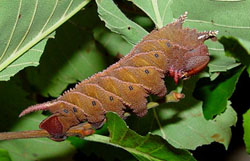 |
Ceratomia amyntor
WO,
the Elm Sphinx or Four-horned Sphinx
Larvae feed on Elm (Ulmus), birch (Betula), basswood
(Tilia), and cherry (Prunus).
There are both green and brown forms. The four horns near
the head are diagnostic. |
 |
Note the pinkish-orange tail, spiracles outlined in red and the cream
stripes on the head.
The dramatic color change from the dorsal
yellow-green to the lateral light greyish-blue is not always
as intense as in this image.
|
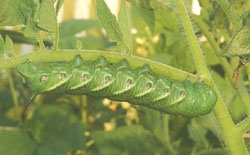 |
Manduca quinquemaculatus
WO,
the Five-spotted Hawkmoth
The caterpillars are called Tomato Hornworms and each has a black horn at the end of the abdomen.
There are brown forms as well as green ones.
Larvae feed on potato, tobacco, tomato, and other plants in the
nightshade family (Solanaceae).
|
 |
Note the red horn and black dots anterior to the white oblique lines.
If you grow tomatoes, you have probably encountered it.
Emily Balsley found one on her pepper plants.
|
 |
Sphinx chersis
WO, the Northern Ash Sphinx or Great Ash
Sphinx:
The larvae are pale bluish green. The head has a pair of yellow
lateral bands meeting at the apex. The oblique, lateral stripes are
pale and bordered anteriorly with a darker green.
Larval hosts are ash, lilac, privet, cherry, and quaking aspen.
|
 |
Larvae hide in the day and feed primarily on cherry, plum, and apple
at night. Larvae have been found on Amelanchier nantuckensis
in Massachusetts and have been reared to pupation in Michigan on
Prunus serotina. Note purple oblique lines.
|
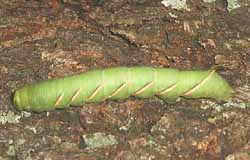 |
Sphinx luscitiosa
WO,
the Canadian Sphinx or
Clemen's Sphinx
This one is reported from Richmond and from northeastern New
Jersey into southern Canada.
|
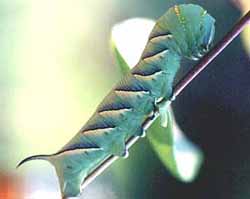 | Larvae feed on the common snowberry (Symphoricarpos albus)
and on coralberry (S. orbiculatus). Note the two golden
lines of slightly raised bumps, one just behind the head, the other
on the thorax.
|
Smerinthini Tribe:
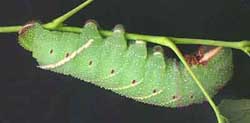 |
Pachysphinx modesta
WO,
the Modest Sphinx or Poplar Sphinx
This moth is not officially recorded in Laramie County. It is fond
of poplars and
willows.
|
 |
Larvae feed on cottonwood and poplar (Populus) and willow
(Salix).
Larvae are very chunky with little to distinguish them
from Pachysphinx modesta.
|
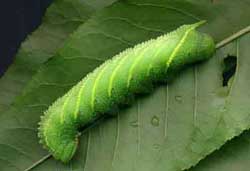 |
Larvae accept willows, birches, and cherries.
I have also found them in the wild on oak in eastern Canada.
|
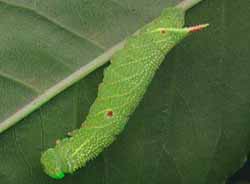 |
Wild cherry species are the favorites as larval foodplants, but eggs
will also be deposited on birches and other forest trees.
There are varying degrees in the amount of red markings along the sides.
|
 |
Smerinthus cerisyi
WO,
Cerisy's Sphinx;
Cerisyi larvae greatly resemble modesta larvae, both being pale
green, with granular skin, pale lateral diagonal lines, faint red
spiracular circles, and very pale longitudinal lines running from the
head to a more pronounced anal diagonal line.
Larvae have green heads bounded dorsally with a pale yellow
inverted "V".
|
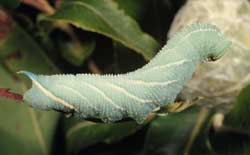 |
Larvae feed upon many forest trees including birches and cherries,
but are expecially fond of poplars and willows. Red markings on sides
vary greatly from specimen to specimen.
|
Macroglossinae subfamily
Dilophonotini Tribe
 |
Hemaris thysbe
WO, the Hummingbird Clearwing
There is also an orangey-pink prepupal form. The lateral line runs
from S1 to the blue horn.
Hemaris thysbe larvae feed on viburnum and related plants.
|
Philampelini Tribe:
 |
Larvae feed upon Grape (Vitis), Virginia Creeper
(Parthenocissus quinquefolia) and other vines and ivies
(Ampelopsis).
Larvae occur in both a light (green) form and a darker (tan/brown)
form. Note six "segmented" oblique lines.
|
Eumorpha achemon larvae, Cheyenne, August 27, 2010,
courtesy of Cristina J. Sheats.
Macroglossini Tribe
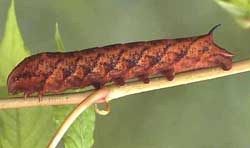 |
In additon to Virginia creeper larvae accept Grape (Vitis),
ampelopsis (Ampelopsis), and cayenne pepper (Capsicum).
Larvae are green until the final instar.
|
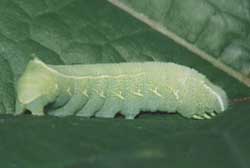 |
Darapsa myron
WO, the Virginia Creeper Sphinx or the Grapevine Sphinx
If you have the
foodplants indicated in the common names, you probably have this
species nearby. The lower wings are orange.
Larvae feed on Virginia creeper (Parthenocissus quinquefolia),
Grape (Vitis), Ampelopsis, and Viburnum.
|
 |
Hyles gallii
WO, the Bedstraw Hawk Moth
or Gallium Sphinx
Larvae come in black and in brown forms and often feed on
Epilobium (fireweed).
|
 |
Hyles lineata
CJS/USGS, the White-lined Sphinx
Larvae are highly varied and feed on a great diversity of plants
including willow weed (Epilobium), four o'clock (Mirabilis),
apple (Malus), evening primrose (Oenothera), elm
(Ulmus), grape (Vitis), tomato (Lycopersicon),
purslane (Portulaca), and Fuschia.
All larvae seem, however, to have the red/black swellings split by
dorso-lateral lines.
|
Hyles lineata larvae, Cheyenne, 2008,
courtesy of Cristina J. Sheats.
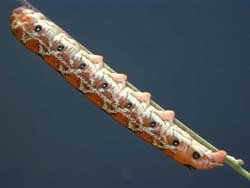 |
Newly-hatched caterpillars eat their eggshells. Larvae feed on
(Onagraceae) including evening primrose (Oenothera), gaura (Gaura),
and willow weed (Epilobium). Michael Van Buskirk has found them on
Guara biennis in Missouri. rare
|
|
|
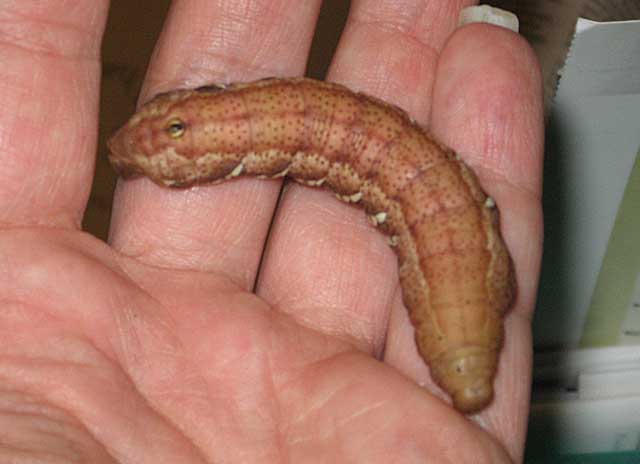
Eumorpha achemon fifth instar, Cheyenne, Laramie County, Wyoming,
August 27, 2010, courtesy of Cristina J. Sheats.
Enjoy some of nature's wonderments, giant silk moth cocoons.
These cocoons are for sale winter and fall. Beautiful Saturniidae moths will emerge the following spring and summer.
Read Actias luna rearing article.
Additional online help available.
Eggs of many North American species are offered during the spring and summer. Occasionally
summer Actias luna and summer Antheraea polyphemus cocoons are available. Shipping to US destinations is done
from within the US.
Use your browser "Back" button to return to the previous page.
This page is brought to you by
Bill Oehlke and the
WLSS. Pages are on space rented from Bizland. If you would like
to become a "Patron of the Sphingidae Site", contact Bill.
Please send sightings/images to Bill. I will do my best to respond to
requests for identification help.
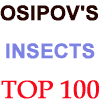 | 
Show appreciation for this site by clicking on flashing butterfly to the left.
The link will take you to a page with links to many insect sites. |



